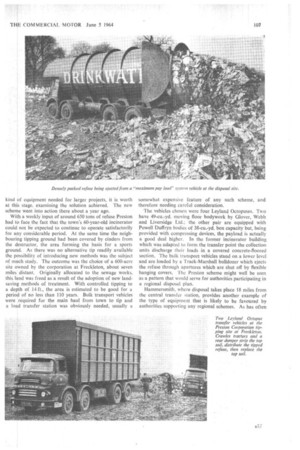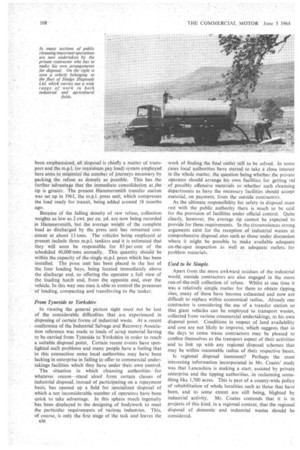PURSUIT OF SPACE
Page 107

Page 108

Page 109

Page 110

If you've noticed an error in this article please click here to report it so we can fix it.
By Ashley Taylor, A.M.I.R.T.E., Assoc. Inst. T. CHANGE is constant, a fact well illustrated by the history of public cleansing, and today many local authorities face a new challenge in the shape of land shortage. This problem arises in other countries besides Britain. In Holland, for instance, there is a growing need to find fresh means of refuse disposal consequent upon a rise in population and a reduction in the areas available for controlled tipping. The increasingly urban character of the countryside at home draws a constant cry from cleansing officers as to where space is to be found for refuse disposal purposes.
A new look is being taken at the situation and the thoughts of planners have turned to a dual-purpose solution in the form of large-scale regional refuse disposal systems as part of co-ordinated schemes. These would be designed not only to assist cleansing officials but also to eliminate the ugly remains of earlier industry and to turn barren, worked-out ground into something that will provide pleasure for the present and future generations. Psychologically, public cleansing has always suffered from the disadvantage that the carrying away of unwanted material is very much a negative activity but at one move the regional plan would transform the work into something positive, creative, and much more attractive to the average man. Implementation of such plans would quickly alter the whole pattern of cleansing fleets. Brief consideration will show that the first necessity in regional disposal would be the provision of giant capacity vehicles on a greatly increased scale to deal with the series of relatively lengthy bulk hauls. The establishment of transfer stations, possibly with some form of compressing facilities, would also be desirable. Whilst in certain districts the use of rail or water transport for the " trunk-line " work cannot be'ruled out, for all practical purposes road transport appears likely to bear the brunt of the work in any such schemes. Specialized, large-capacity vehicles have been introduced by the manufacturers in increasing numbers in recent years, and have been accepted by the cleansing world for employment in limited spheres, so that adaptation of fleets to a new role would present little difficulty. '
7963 Report Important features of central waste disposal and plans for land reclamation were described in a study prepared in 1963 for the Southport Conference of the Institute of Public Cleansing by Mr. U. Aylmer Coates, the Lancashire county planning officer. His county makes the proud claim that in pilot schemes and experimental projects they have already reclaimed nearly 200 acres for playing fields, B34
agricultural purposes, housing and industrial developments. chiefly in the coalfields-area. In his paper Mr. Coates pointed out that whilst fresh projects of every kind made serious inroads into the available space, land used for food production often being thus consumed, where derelict areas can be restored to sound employment every acre is a national asset which eases the pressure of scarcity that is passed on to the individual in a thousand and one ways.
Ugly features of the landscape are in many parts of the country already being gradually eliminated and the blots that were created when industrialism ran mad in Britain are being marked down for treatment. Disposal at a distance is nothing new, but widespread building development is on the verge of forcing action in this connection on many authorities who would not otherwise have contemplated the step. There are few places where this disposal problem is more serious than in Lancashire and the country has many sites where filling and covering could convert useless areas into sports grounds and other projects of great amenity value to the population of the surrounding area.
The magnitude of this field, and the scale of equipment conversion likely to be required in respect of any sustained change over, can be gauged from figures quoted by Mr. Coates which show that in Lancashire alone there are some 19,000 acres of derelict land. Of these, 11,000 are completely wasteland, whilst the remainder have resulted from extractive and industrial activity in past times. A further 15,000 acres are in current use for mineral operations and waste tipping. Against this background one finds cleansing authorities cogitating anxiously about their future land requirements. The answer, many people feel, must be co-ordination between the two.
Where long-term refuse disposal is being considered not many cleansing undertakings are so fortunate as Preston, Lanes, which, in the highly unlikely event of conditions remaining unchanged for over a century, will have all the space necessary throughout that period. Since Preston's experience demonstrates something of current practice in meeting disposal problems and also gives a glimpse of the kind of equipment needed for larger projects, it is worth at this stage, examining the solution achieved. The new scheme went into action there about a year ago.
With a weekly input of around 650 tons of refuse Preston had to face the fact that the town's 60-year-old incinerator could not be expected to continue to operate satisfactorily for any considerable period. At the same time the neighbouring tipping ground had been covered by cinders from the destructor, the area forming the basis for a sports ground. As there was no alternative tip readily available the possibility of introducing new methods was the subject of much study. The outcome was the choice of a 600-acre site owned by the corporation at Freckkton, about seven miles distant. Originally allocated to the sewage works, this land was freed as a result of the adoption of new landsaving methods of treatment. With controlled tipping to a depth of 14 ft., the area is estimated to be good for a period of no less than 110 years. Bulk transport vehicles were required for the main haul from town to tip and a load transfer station was obviously needed, usually a somewhat expensive feature of any such scheme, and therefore needing careful consideration.
The vehicles chosen were four Leyland Octopuses. Two have 49-cu.-yd. moving floor bodywork by Glover, Webb and Liversidge Ltd.: the other pair are equipped with Powell Duffryn bodies of 38-cu.-yd. box capacity but, being provided with compressing devices, the payload is actually a good deal higher. In the former incinerator building which was adapted to form the transfer point the collection units discharge their loads in a covered concrete-floored section. The bulk transport vehicles stand on a tower level and are loaded by a Track-Marshall bulldozer which ejects the refuse through apertures which are shut off by flexible hanging covers. The Preston scheme might well be seen as a pattern that would serve for authorities participating in a regional disposal plan.
Hammersmith, where disposal takes place 18 miles from the central transfer station, provides another example of the type of equipment that is likely to be favoured by authorities supporting any regional schemes. As has often
been emphasisized, all disposal is chiefly a matter of trans port and the (or maximum pay load) system employed here aims to minimize the number of journeys necessary by packing the refuse as densely as possible. This has the further advantage that the immediate consolidation at„the tip is greater. The present Hammersmith transfer station was set up in 1961, the m.p.I. press unit, which compresses the load ready for transit, being added around 18 months ago.
Because of the falling density of raw refuse, collection weights as low as 2 cwt. per cu. yd. are now being recorded in Hammersmith, but the average weight of the complete load as discharged by the press unit has remained consistent at about 13 tons. The vehicles being employed at present include three m.p.l. tankers and it is estimated that they will soon be responsible for 85 per cent of the scheduled 40,000 tons annually. This quantity should be within the capacity of the single m.p.I. press which has been installed. The press unit has been placed in the last of the four loading bays, being located immediately above the discharge end, so offering the operator a full view of the loading hatch end, from the opposite end, over the vehicle. In this way one man is able to control the processes of loading, compacting and transferring to the tanker.
From Tyneside to Yorkshire
In viewing the general picture sight must not be lost of the considerable difficulties that are experienced in disposing of certain forms of industrial waste. At a recent conference of the Industrial Salvage and Recovery Association reference was made to loads of scrap material having to be carried from Tyneside to Yorkshire in order to reach a suitable disposal point. Certain recent events have spotlighted such problems and many people have a feeling that in this connection some local authorities may have been lacking in enterprise in failing to offer to commercial undertakings facilities which they have under their own control.
The situation in which cleansing authorities—for whatever reason—stand aloof from certain classes of industrial disposal, instead of participating on a repayment basis, has opened up a field for specialized disposal of which a not inconsiderable number of operators have been quick to take advantage. In this sphere much ingenuity has been displayed in the designing of bodywork to meet the particular requirements of various industries. This, of course, is only the first stage of the task and leaves the 836
work of finding the final outlet still to be solved. In some cases local authorities have started to take a close interest in the whole matter, the question being whether the private operator should arrange his own facilities for getting rid of possibly offensive materials or whether such cleansing departments as have the necessary facilities should aecept material, on payment, from the outside contractors.
As the ultimate responsibility for safety in disposal must rest with the public authority there is much to be said for the provision of facilities under official control. Quite clearly, however, the average tip cannot be expected to provide for these requirements. In the circumaances strong arguments exist for the reception of industrial wastes at comprehensive disposal sites such as those under discussion where it might be possible to make available adequate on-the-spot inspection as well as adequate outlets, for problem materials.
Used to be Simple Apart from the more awkward residues of the industrial world, outside contractors are also engaged in the more run-of-the-mill collection of refuse. Whilst at one time it was a relatively simple matter for them to obtain tipping sites, many of these have become exhausted and now are difficult to replace within economical radius. Already one contractor is considering the use of a transfer station so that giant vehicles can be employed to transport wastes, collected from various commercial undertakings, to his own disposal point. Conditions in respect of land availability and cost are not likely to improve, which suggests that in the days to come waste contractors may be pleased to confine themselves to the transport aspect of their activities and to link up with any regional disposal schemes that may be within reasonable radius of their respective bases.
Is regional disposal imminent? Perhaps the most interesting information incorporated in Mr. Coates' study was that Lancashire is making a start, assisted by private enterprise and the tipping authorities, in reclaiming something like 1,700 acres. This is part of a county-wide policy of rehabilitation of whole localities such as those that have been, and to some extent are still being, blighted by
industrial activity. Mr. Coates contends that it is in projects of this kind, in a regional context, that the regional disposal of domestic and industrial wastes should be conside red.












































































































































































